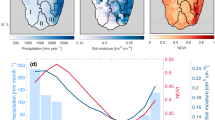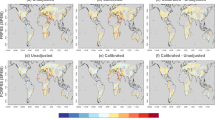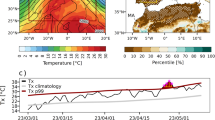Abstract
Food insecurity early warning can provide time to mitigate unfolding crises; however, drought remains a large source of uncertainty. The challenge is to filter unclear or conflicting signals from various climatic and socio-economic variables and link them to food security outcomes. Integrating lag-1 autocorrelation diagnostics into remotely sensed observations from the Soil Moisture Active Passive (SMAP) mission and food prices, we found dramatic improvement in anticipating the timing and intensity of food crises, except in conflict settings. We analysed drought-induced food crises globally in the SMAP record (since 2015; approximately five per year). The change in soil moisture autocorrelation, which we term the Soil Moisture Auto-Regressive Threshold (SMART), signalled an accurate food security transition for all cases studied here (P < 0.05; n = 212), including lead time of up to three to six months for every case. The SMART trigger anticipates the timing of the transition and the magnitude of the food security change among small to large transitions, both into and out of crises (R2 = 0.80–0.83). While we do not evaluate out-of-sample forecast accuracy using our model, our findings suggest a significant advancement in the capabilities of food security early-warning diagnostics and could save lives and resources.
This is a preview of subscription content, access via your institution
Access options
Access Nature and 54 other Nature Portfolio journals
Get Nature+, our best-value online-access subscription
$29.99 / 30 days
cancel any time
Subscribe to this journal
Receive 12 digital issues and online access to articles
$119.00 per year
only $9.92 per issue
Buy this article
- Purchase on Springer Link
- Instant access to full article PDF
Prices may be subject to local taxes which are calculated during checkout




Similar content being viewed by others
Data availability
All data used in this study are publicly available through the NASA National Snow and Ice Data Center (NSIDC) website (https://nsidc.org/data/smap/smap-data.html), the FEWS NET Data Portal (https://fews.net/fews-data/333) and the FAO Food Price Monitoring and Analysis (FPMA) Tool (https://www.fao.org/giews/food-prices/price-tool/en/).
Code availability
All code used in this study is available upon request or at https://github.com/Krishna2609.
References
Dakos, V., Carpenter, S. R., van Nes, E. H. & Scheffer, M. Resilience indicators: prospects and limitations for early warnings of regime shifts. Philos. Trans. R. Soc. B 370, 20130263 (2015).
Berg, A. & Sheffield, J. Climate change and drought: the soil moisture perspective. Curr. Clim. Change Rep. 4, 180–191 (2018).
Benton, T. et al. Environmental Tipping Points and Food System Dynamics: Main Report (Global Food Security Programme UK, 2017).
Mathys, E. Trigger Indicators and Early Warning and Response Systems in Multi‐Year Title II Assistance Programs (Food and Nutrition Technical Assistance Project 20, 2007).
Wilkinson, E. et al. Forecasting Hazards, Averting Disasters: Implementing Forecast-Based Early Action at Scale (Overseas Development Institute, 2018).
Krishnamurthy, P. K., Choularton, R. J. & Kareiva, P. Dealing with uncertainty in famine predictions: how complex events affect food security early warning skill in the Greater Horn of Africa. Glob. Food Secur. 26, 100374 (2020).
Sepulcre-Canto, G., Horion, S. M. A. F., Singleton, A., Carrao, H. & Vogt, J. Development of a combined drought indicator to detect agricultural drought in Europe. Nat. Hazards Earth Syst. Sci. 12, 3519–3531 (2012).
Svoboda, M. et al. The drought monitor. Bull. Am. Meteorol. Soc. 83, 1181–1190 (2002).
Beneke, C., Chartrand, R., Kontgis, C. & Rich, D. in Remote Sensing for Agriculture, Ecosystems, and Hydrology XXI (International Society for Optics and Photonics, 2019), 62–72, https://doi.org/10.1117/12.2532840
Rembold, F. et al. ASAP: a new global early warning system to detect anomaly hot spots of agricultural production for food security analysis. Agric. Syst. 168, 247–257 (2019).
Ogallo, L. et al. Adapting to climate variability and change: the Climate Outlook Forum process. Bull. World Meteorol. Organ. 57, 93–102 (2008).
de la Casa, A., Ovando, G. & Díaz, G. Linking data of ENSO, NDVI-MODIS and crops yield as a base of an early warning system for agriculture in Córdoba, Argentina. Remote Sens. Appl.: Soc. Environ. 22, 100480 (2021).
Becker-Reshef, I., Vermote, E., Lindeman, M. & Justice, C. A generalized regression-based model for forecasting winter wheat yields in Kansas and Ukraine using MODIS data. Remote Sens. Environ. 114, 1312–1323 (2010).
Husak, G. J., Funk, C., Michaelsen, J., Magadzire, T. & Goldsberry, K. P. Developing seasonal rainfall scenarios for food security early warning. Theor. Appl. Climatol. 114, 291–302 (2013).
Funk, C. & Shukla, S. Drought Early Warning and Forecasting: Theory and Practice (Elsevier, 2020).
Walker, P. Famine Early Warning Systems: Victims and Destitution (Routledge, 2013).
Kalkuhl, M., Von Braun, J. & Torero, M. Food Price Volatility and Its Implications for Food Security and Policy (Springer, 2016).
Lentz, E. C., Michelson, H., Baylis, K. & Zhou, Y. A data-driven approach improves food insecurity crisis prediction. World Dev. 122, 399–409 (2019).
Maxwell, D. Famine Early Warning and Information Systems in Conflict Settings: Challenges for Humanitarian Metrics and Response (LSE/Conflict Research Programme 2019).
Zhu, Q. et al. Satellite soil moisture for agricultural drought monitoring: assessment of SMAP-derived soil water deficit index in Xiang River Basin, China. Remote Sens. 11, 362 (2019).
Sadri, S. et al. Wood. A global near-real-time soil moisture index monitor for food security using integrated SMOS and SMAP. Remote Sens. Environ. 246, 111864 (2020).
Bolten, J. D., Crow, W. T., Zhan, X., Jackson, T. J. & Reynolds, C. A. Evaluating the utility of remotely sensed soil moisture retrievals for operational agricultural drought monitoring. IEEE J. Sel. Top. Appl. Earth Obs. Remote Sens. 3, 57–66 (2009).
Cleverly, J. et al. Soil moisture controls on phenology and productivity in a semi‐arid critical zone. Sci. Total Environ. 568, 1227–1237 (2016).
Krishnamurthy R, P. K., Fisher, J. B., Schimel, D. S. & Kareiva, P. M. Applying tipping point theory to remote sensing science to improve early warning drought signals for food security. Earth’s Future 8, e2019EF001456 (2020).
Lenton, T. M. Early warning of climate tipping points. Nat. Clim. Change 1, 201–209 (2011).
Preiser, R., Biggs, R., De Vos, A. & Folke, C. Social-ecological systems as complex adaptive systems. Ecol. Soc. 23, (2018).
Integrated Food Security Phase Classification Manual Ver. 3.0 (IPC Global Partners, 2019).
Willett, W. et al. Food in the Anthropocene: the EAT–Lancet Commission on healthy diets from sustainable food systems. Lancet 393, 447–492 (2019).
Baro, M. & Deubel, T. F. Persistent hunger: perspectives on vulnerability, famine, and food security in sub-Saharan Africa. Annu. Rev. Anthropol. 35, 521–538 (2006).
Kenya—Key Message Update September 2017 (FEWS NET Kenya, 2017).
Verification Products: Greater Horn of Africa Climate Outlook Forum (ICPAC, 2019).
Walker, D. P. et al. Skill of dynamical and GHACOF consensus seasonal forecasts of East African rainfall. Clim. Dyn. 53, 4911–4935 (2019).
Jjemba, E. W., Mwebaze, B. K., Arrighi, J., de Perez, E. C. & Bailey, M. in Resilience (eds Zommers, Z. & Alverson, K.) 237–242 (Elsevier, 2018).
He, X. et al. Integrated approaches to understanding and reducing drought impact on food security across scales. Curr. Opin. Environ. Sustainability 40, 43–54 (2019).
Lowder, S. K., Bertini, R. & Croppenstedt, A. Poverty, social protection and agriculture: levels and trends in data. Glob. Food Sec. 15, 94–107 (2017).
Hazell, P. B. in Agriculture & Food Systems to 2050: Global Trends, Challenges and Opportunities, Vol. 4 (eds Serraj, R. & Pingali, P.) 37–160 (World Scientific, 2019).
Dithmer, J. & Abdulai, A. Does trade openness contribute to food security? A dynamic panel analysis. Food Policy 69, 218–230 (2017).
Funk, C. et al. Recognizing the Famine Early Warning Systems Network: over 30 years of drought early warning science advances and partnerships promoting global food security. Bull. Am. Meteorol. Soc. 100, 1011–1027 (2019).
Martin-Shields, C. P. & Stojetz, W. Food security and conflict: empirical challenges and future opportunities for research and policy making on food security and conflict. World Dev. 119, 50–164 (2019).
Schauberger, B., Jägermeyr, J. & Gornott, C. A systematic review of local to regional yield forecasting approaches and frequently used data resources. Eur. J. Agron. 120, 126153 (2020).
Schwalbert, R. et al. Mid‐season county‐level corn yield forecast for US corn belt integrating satellite imagery and weather variables. Crop Sci. 60, 739–750 (2020).
Boogaard, H., van der Wijngaart, R., van Kraalingen, D., Meroni, M. & Rembold, F. ASAP Water Satisfaction Index (EU-JRC, 2018).
FAO, IFAD, UNICEF, WFP & WHO The State of Food Insecurity 2019: Safeguarding Against Economic Slowdowns and Downturns (FAO, 2019).
Reichle, R. H. et al. Assessment of the SMAP level-4 surface and root-zone soil moisture product using in situ measurements. J. Hydrometeorol. 18, 2621–2645 (2017).
Skofronick-Jackson, G. et al. The Global Precipitation Measurement (GPM) mission for science and society. Bull. Am. Meteorol. Soc. 98, 1679–1695 (2017).
MODIS and VIIRS Land Products Global Subsetting and Visualization Tool (ORNL DAAC, 2020).
Lemoine, J. M., Bourgogne, S., Biancale, R. & Gégout, P. The new GRGS-RL04 series of mass variations modelled with GRACE data. In (ed.) EGU General Assembly 20th EGU General Assembly Conference Abstracts 18624 (EGU, 2018).
Dakos, V. et al. Slowing down as an early warning signal for abrupt climate change. P. Natl Acad. Sci. USA 105, 14308–14312 (2008).
Takimoto, G. Early warning signals of demographic regime shifts in invading populations. Popul. Ecol. 51, 419–426 (2009).
Golledge, N. R. et al. Antarctic climate and ice‐sheet configuration during the early Pliocene interglacial at 4.23 Ma. Clim. Past 13, 959–975 (2017).
Wieczorek, S., Ashwin, P., Luke, C. M. & Cox, P. M. Excitability in ramped systems: the compost‐bomb instability. Philos. Trans. R. Soc. A 467, 1243–1269 (2011).
Dakos, V., van Nes, E. H., d’Odorico, P. & Scheffer, M. Robustness of variance and autocorrelation as indicators of critical slowing down. Ecology 93, 264–271 (2012).
Dakos, V. et al. Methods for detecting early warnings of critical transitions in time series illustrated using simulated ecological data. PloS ONE 7, (2012).
Kalkuhl, M., von Braun, J. & Torero, M. in Food Price Volatility and Its Implications for Food Security and Policy (eds Kalkuhl, M., von Braun, J. & Torero, M.) 3–31 (Springer, 2016).
Acknowledgements
This research was carried out, in part, at the Jet Propulsion Laboratory, California Institute of Technology, under a contract with the National Aeronautics and Space Administration (NASA) and funded through the Internal Strategic University Research Partnerships (SURP) programme. P.K.K.R. was supported, in part, by SURP and UCLA’s Institute of the Environment and Sustainability. J.B.F. was supported, in part, by NASA programmes Science Utilization of SMAP (SUSMAP) and NASA Climate Indicators and Data Products for Future National Climate Assessments (INCA). The funders had no role in study design, data collection and analysis, decision to publish or preparation of the manuscript. A. Barreca, M. Gebremichael and T. Gillespie provided useful feedback to earlier drafts of this paper.
Author information
Authors and Affiliations
Contributions
P.K.K.R. first conceptualized the study, conducted all data analysis, performed all statistical tests and generated the figures; P.K.K.R., J.B.F. and P.M.K. contributed to designing the methodology. All authors wrote and edited the manuscript.
Corresponding author
Ethics declarations
Competing interests
The authors declare no competing interests.
Peer review
Peer review information
Nature Sustainability thanks David MacLeod and the other, anonymous, reviewer(s) for their contribution to the peer review of this work.
Additional information
Publisher’s note Springer Nature remains neutral with regard to jurisdictional claims in published maps and institutional affiliations.
Supplementary information
Supplementary Information
Supplementary Methods, Results, Discussion, Figs. 1–12 and Tables 1–3.
Rights and permissions
Springer Nature or its licensor holds exclusive rights to this article under a publishing agreement with the author(s) or other rightsholder(s); author self-archiving of the accepted manuscript version of this article is solely governed by the terms of such publishing agreement and applicable law.
About this article
Cite this article
Krishnamurthy R, P.K., Fisher, J.B., Choularton, R.J. et al. Anticipating drought-related food security changes. Nat Sustain 5, 956–964 (2022). https://doi.org/10.1038/s41893-022-00962-0
Received:
Accepted:
Published:
Issue Date:
DOI: https://doi.org/10.1038/s41893-022-00962-0
This article is cited by
-
Remotely sensing potential climate change tipping points across scales
Nature Communications (2024)
-
Global land drought hubs confounded by teleconnection hotspots in equatorial oceans
npj Climate and Atmospheric Science (2024)
-
Drought tolerance and impacts of four rootstock genotypes on the morphology, yield and fruit quality of Fuji scion apple under drought conditions
Horticulture, Environment, and Biotechnology (2024)
-
Hybrid photothermal–photocatalyst sheets for solar-driven overall water splitting coupled to water purification
Nature Water (2023)
-
Higher Intercellular CO2 Concentration is Associated with Improved Water Use Efficiency and Drought Tolerance in Bread Wheat
Gesunde Pflanzen (2023)



